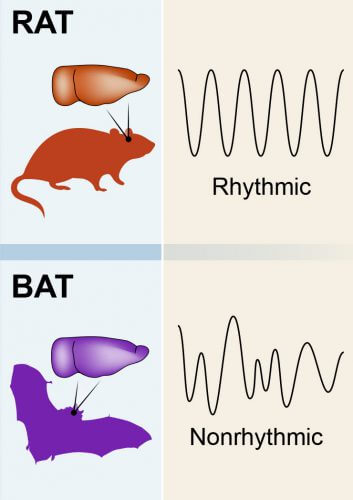In a new study, published this weekend in the scientific journal Cell, Weizmann Institute of Science scientists showed that bats encode physical space without periodic brain waves. The scientists estimate that similar coding also exists in humans and monkeys

"You can order a car in any color you want, as long as it is black," said the industrialist Henry Ford about the Ford T - the first car model in history that was marketed to the masses. If we lived in a world where cars are always black, we might think that the color black is essential to their function, just like the engine. Since they were discovered in the 20s of the last century, periodic brain waves are considered essential for neural coding in the brain - and in particular for the coding of physical space in the area of the brain called the hippocampus. Could it be that, like the color of the car, these waves are only a secondary feature? In a new study, published this weekend in the scientific journal Cell, Weizmann Institute of Science scientists showed that bats encode physical space without periodic brain waves. The scientists estimate that similar coding also exists in humans and monkeys. Prof. Nachum Ulanovsky from the Department of Neurobiology says: "Neural coding of this type is a new concept in neuroscience. This is the first time, to the best of our knowledge, that such a mechanism has been demonstrated in any species and in any area of the brain."

The electrical activity in rats versus bats. "In humans and monkeys, the activity measured is much closer to bats than to rats"
Cyclic patterns of electrical activity in the brain were discovered about 100 years ago, with the invention of the electroencephalograph (EEG) device. These waves have been the focus of researchers' interest for many decades, and they are attributed great importance in the functioning of the brain and the ability of nerve cells and different areas of the brain to synchronize their activity. Special research interest has been devoted to theta waves - waves with a frequency of 6-10 Hz measured in the hippocampus of model animals such as a mouse or rat - and over the years have been linked to many theories of memory and navigation.
In a previous study, researchers in Prof. Ulanovsky's bat lab showed that theta waves do not appear in these flying mammals. The scientific community partly had difficulty accepting the findings. "When we said there are no theta waves in bats, it caused an uproar. I had arguments with very senior scientists who had a hard time digesting the findings", says Prof. Ulanovsky. In the current study, led by research student Tamir Eliav, the researchers first established the absence of theta waves in bats. They recorded the electrical activity in additional cell types in the hippocampus, and looked at a much wider range of frequencies, and still the bats were on their own: no cyclical pattern of electrical activity was found.
This kind of neural coding is a new concept in neuroscience. This is the first time, to the best of our knowledge, that such a mechanism has been demonstrated in any species and in any area of the brain."
If theta waves are essential for navigation, how are navigation functions and spatial memory maintained in bats, which are known to be excellent navigators? Eliav and other researchers in Prof. Ulanovsky's group showed that, despite the absence of these waves, the spatial coding mechanism exists in bats well without them. Besides theta waves, the coding mechanism known from mice and rats consists of two other features - "phase locking" and "phase coding". Phase locking describes a situation where the neurons in the hippocampus are synchronized with the periodic waves, so that the neurons fire near a certain point in the theta wave cycle. Phase coding occurs when a neuron representing a specific location in space fires at an increasing rate as the animal approaches this location - and the timing of the firing with the theta wave occurs at an earlier and earlier point. The scientists discovered that a similar mechanism exists in bats: the activity of almost half of the neurons in their hippocampus was significantly "locked" to the non-periodic electrical oscillations in their brains. Also, when the bats approached a certain location, the neurons representing that location fired at an earlier timing relative to the non-periodic oscillations. In other words, the principle of coordination between neurons is preserved, as well as the neural coding of space and time. "In humans and monkeys, the electrical activity measured is much closer to bats than to rats. Therefore, we hypothesize that this mechanism also characterizes the brains of primates", says Eliav.
"Beyond the specific findings, the study is also an example of the power of a comparative research approach," says Prof. Ulanovsky. "In the 70s and 80s, there were studies in a variety of animals, and for various reasons, some of them very good, the research shifted to focus on a few model animals. Because mice and rats are such dominant model animals, and more than 90% of research focuses on them, people sometimes make the mistake of thinking that what they find in these animals is true for all mammals. Theta waves, phase locking and phase encoding are considered a packet transaction. We have shown in the present study that bats do not have theta waves, but the other two features - phase locking and phase coding - continue to exist. In other words, the comparison with bats made it possible to see which features are evolutionarily preserved, and which are only secondary."
Dr. Maya Geva-Shagiv, Dr. Michael Yertsev, Dr. Arseny Finkelstein, Dr. Alon Rubin and Dr. Liora Les from Prof. Ulanovsky's group also participated in the study.
More of the topic in Hayadan:

One response
Laws of life, in the foreseeable future many experts from all important fields in our world will be enlightened from heaven and thus will be able to explain to humanity things, processes, and phenomena that until now were obscure. Illumination from heaven will reveal to humanity most of the important details that who knows if we were on our own would reach them. Even in the past, throughout the course of human history, experts and various people received enlightenment from heaven and suddenly announced that they had made an important discovery. Most of the discoverers who received enlightenment from heaven were not aware of it, but nowadays all experts who could make discoveries knew for sure that it was enlightenment from heaven.